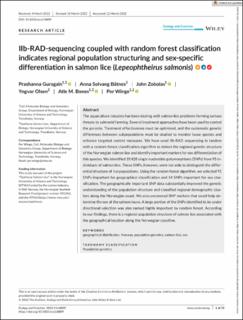| dc.contributor.author | Guragain, Prashanna | |
| dc.contributor.author | Båtnes, Anna Solvang | |
| dc.contributor.author | Zobolas, John | |
| dc.contributor.author | Olsen, Yngvar | |
| dc.contributor.author | Bones, Atle M. | |
| dc.contributor.author | Winge, Per | |
| dc.date.accessioned | 2023-02-02T08:49:49Z | |
| dc.date.available | 2023-02-02T08:49:49Z | |
| dc.date.created | 2022-03-25T14:50:36Z | |
| dc.date.issued | 2022 | |
| dc.identifier.citation | Ecology and Evolution. 2022, 12 (4), 1-15. | en_US |
| dc.identifier.issn | 2045-7758 | |
| dc.identifier.uri | https://hdl.handle.net/11250/3047889 | |
| dc.description.abstract | The aquaculture industry has been dealing with salmon lice problems forming serious threats to salmonid farming. Several treatment approaches have been used to control the parasite. Treatment effectiveness must be optimized, and the systematic genetic differences between subpopulations must be studied to monitor louse species and enhance targeted control measures. We have used IIb-RAD sequencing in tandem with a random forest classification algorithm to detect the regional genetic structure of the Norwegian salmon lice and identify important markers for sex differentiation of this species. We identified 19,428 single nucleotide polymorphisms (SNPs) from 95 individuals of salmon lice. These SNPs, however, were not able to distinguish the differential structure of lice populations. Using the random forest algorithm, we selected 91 SNPs important for geographical classification and 14 SNPs important for sex classification. The geographically important SNP data substantially improved the genetic understanding of the population structure and classified regional demographic clusters along the Norwegian coast. We also uncovered SNP markers that could help determine the sex of the salmon louse. A large portion of the SNPs identified to be under directional selection was also ranked highly important by random forest. According to our findings, there is a regional population structure of salmon lice associated with the geographical location along the Norwegian coastline. | en_US |
| dc.language.iso | eng | en_US |
| dc.publisher | Wiley | en_US |
| dc.rights | Navngivelse 4.0 Internasjonal | * |
| dc.rights.uri | http://creativecommons.org/licenses/by/4.0/deed.no | * |
| dc.title | IIb-RAD-sequencing coupled with random forest classification indicates regional population structuring and sex-specific differentiation in salmon lice (Lepeophtheirus salmonis) | en_US |
| dc.title.alternative | IIb-RAD-sequencing coupled with random forest classification indicates regional population structuring and sex-specific differentiation in salmon lice (Lepeophtheirus salmonis) | en_US |
| dc.type | Peer reviewed | en_US |
| dc.type | Journal article | en_US |
| dc.description.version | publishedVersion | en_US |
| dc.source.pagenumber | 1-15 | en_US |
| dc.source.volume | 12 | en_US |
| dc.source.journal | Ecology and Evolution | en_US |
| dc.source.issue | 4 | en_US |
| dc.identifier.doi | 10.1002/ece3.8809 | |
| dc.identifier.cristin | 2012618 | |
| cristin.ispublished | true | |
| cristin.fulltext | original | |
| cristin.qualitycode | 1 | |

